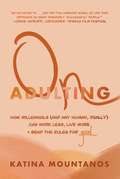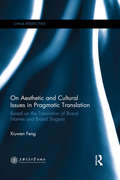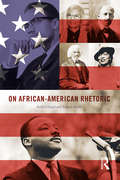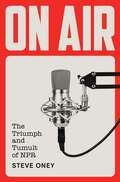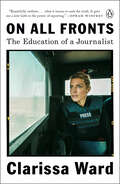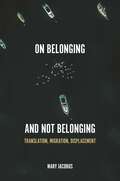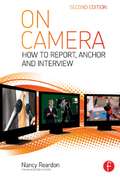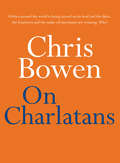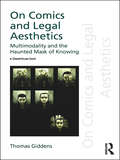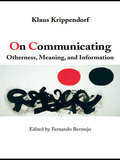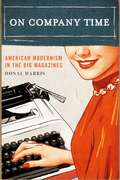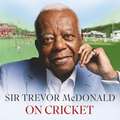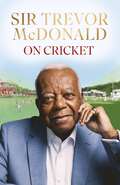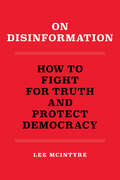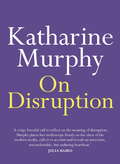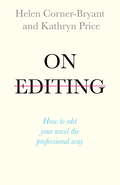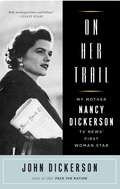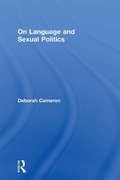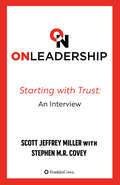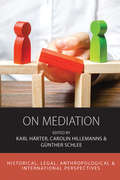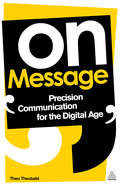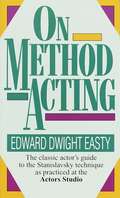- Table View
- List View
On Adulting: How Millennials (And Any Human, Really) Can Work Less, Live More, And Bend The Rules For Good
by Katina MountanosThe go-to guide for millennials who are confused about growing up—and need advice on how to do so in a mindful, happy way. If you feel like the moment you entered adulthood your entire life has become a negotiation rather than a choice, you're not alone. Millions of adults around the world feel like they're not living up to their potential. But, mindset coach and creative entrepreneur Katina Mountanos has a secret: it's possible to get off the work-gym-sleep hamster wheel—and never look back. In On Adulting: A Guide To Growing Up In A Mindful, Happy Way, Mountanos shares her exact formula for crafting an adult life that's full of choices. Through her wildly popular blog and community, she's helped thousands of millennials start telling the truth about what they actually want their life to look like. And now, she's helping readers everywhere escape the rat race, make bill-paying and laundry more fun, and live a life they're passionate about. You'll learn Mountanos's blueprint for being a mindful and happy grown-up, which includes: Why you're addicted to collecting praise and trophies from a scientific perspective - and how to put an end to itHow to stop following "the rules" even when it feels impossible because you're chained to your paycheckHow to figure out what your passion is in less than 24-hours using a little known creative exerciseLearning a mindset shift that you can apply to boring adulthood tasks such as paying off your loans or meal prepping on Sunday evenings How to navigate the shift in relationships—friendships, familial, romantic—as you grow, through advice from expertsDeveloping a clear personal mission statement that guides who you want to be when you grow up, not only what.On Adulting is packed with tactical tips, real-life stories, and expert advice in order to live a mindful, happy, and conscious life.
On Aesthetic and Cultural Issues in Pragmatic Translation: Based on the Translation of Brand Names and Brand Slogans (China Perspectives)
by Xiuwen FengThis book focuses on the cross-cultural advertising communication and aesthetic issues of brands and brand slogans. Based on the pragmatic translating theories and case studies of a few classic brand translations, the book puts forward the Three Aesthetic Principles of translating brands. The book special features the cultural in addition to the business aspect of introducing China Time-honored Brands to foreign markets. Readers will learn about the great importance of the aesthetic issues and cultural communications in translating brands and brand slogans through this book.
On African-American Rhetoric
by Keith Gilyard Adam J. BanksOn African-American Rhetoric traces the arc of strategic language use by African Americans from rhetorical forms such as slave narratives and the spirituals to Black digital expression and contemporary activism. The governing idea is to illustrate the basic call-response process of African-American culture and to demonstrate how this dynamic has been and continues to be central to the language used by African Americans to make collective cultural and political statements. Ranging across genres and disciplines, including rhetorical theory, poetry, fiction, folklore, speeches, music, film, pedagogy, and memes, Gilyard and Banks consider language developments that have occurred both inside and outside of organizations and institutions. Along with paying attention to recent events, this book incorporates discussion of important forerunners who have carried the rhetorical baton. These include Frederick Douglass, Harriet Jacobs, Sojourner Truth, Anna Julia Cooper, W. E. B. Du Bois, Zora Neale Hurston, Malcolm X, Martin Luther King, Jr., Toni Cade Bambara, Molefi Asante, Alice Walker, and Geneva Smitherman. Written for students and professionals alike, this book is powerful and instructive regarding the long African-American quest for freedom and dignity.
On Air: The Triumph and Tumult of NPR
by Steve OneyAn epic, decade-long reported history of National Public Radio that reveals the unlikely story of one of America&’s most celebrated but least understood media empires.Founded in 1970, NPR is America&’s most powerful broadcast news network. Despite being overshadowed by the larger and more glamorous PBS, public radio has long been home to shows such as All Things Considered, Morning Edition, and This American Life that captivate millions of listeners in homes, cars, and workplaces across the nation. NPR and its hosts are a cultural force and a trusted voice, and they have created a mode of journalism and storytelling that helps Americans understand the world in which we live. In On Air, a book fourteen years in the making, journalist Steve Oney tells the dramatic history of this institution, tracing the comings and goings of legendary on-air talents (Bob Edwards, Susan Stamberg, Ira Glass, Cokie Roberts, and many others) and the rise and fall and occasional rise again of brilliant and sometimes venal executives. It depicts how NPR created a medium for extraordinary journalism—in which reporters and producers use microphones as paintbrushes and the voices of people around the world as the soundtrack of stories both global and local. Featuring details on the controversial firing of Juan Williams, the sloppy dismissal of Bob Edwards, and a $230 million bequest by Joan B. Kroc, widow of the founder of McDonalds, On Air also chronicles NPR&’s daring shift into the digital world and its early embrace of podcasting formats, establishing the network as a formidable media empire. Fascinating, revelatory, and irresistibly dishy, this is a riveting account of NPR&’s unlikely launch, chaotic ascent, and ultimate triumph—a must-read for anyone interested in the history of public radio and its impact on American culture.
On All Fronts: The Education of a Journalist
by Clarissa Ward&“On All Fronts takes the reader on a riveting journey of storytelling. . . From Russia to China to Syria, [she] navigate[s] the most intense of human experiences while finding the tools to stay emotional.&”—Lynsey Addario, author of It&’s What I Do: A Photographer&’s Life of Love and WarThe recipient of multiple Peabody and Murrow awards, Clarissa Ward is a world-renowned conflict reporter. In this strange age of crisis where there really is no front line, she has moved from one hot zone to the next. With multiple assignments in Syria, Egypt, and Afghanistan, Ward, who speaks seven languages, has been based in Baghdad, Beirut, Beijing, and Moscow. She has seen and documented the violent remaking of the world at close range. With her deep empathy, Ward finds a way to tell the hardest stories. On All Fronts is the riveting account of Ward&’s singular career and of journalism in this age of extremism.Following a privileged but lonely childhood, Ward found her calling as an international war correspondent in the aftermath of 9/11. From her early days in the field, she was embedding with marines at the height of the Iraq War and was soon on assignment all over the globe. But nowhere does Ward make her mark more than in war-torn Syria, which she has covered extensively with courage and compassion. From her multiple stints entrenched with Syrian rebels to her deep investigations into the Western extremists who are drawn to ISIS, Ward has covered Bashar al-Assad&’s reign of terror without fear. In 2018, Ward rose to new heights at CNN and had a son. Suddenly, she was doing this hardest of jobs with a whole new perspective.On All Fronts is the unforgettable story of one extraordinary journalist—and of a changing world.
On Belonging and Not Belonging: Translation, Migration, Displacement
by Mary JacobusA look at how ideas of translation, migration, and displacement are embedded in the works of prominent artists, from Ovid to Tacita DeanOn Belonging and Not Belonging provides a sophisticated exploration of how themes of translation, migration, and displacement shape an astonishing range of artistic works. From the possibilities and limitations of translation addressed by Jhumpa Lahiri and David Malouf to the effects of shifting borders in the writings of Eugenio Montale, W. G. Sebald, Colm Tóibín, and many others, esteemed literary critic Mary Jacobus looks at the ways novelists, poets, photographers, and filmmakers revise narratives of language, identity, and exile. Jacobus’s attentive readings of texts and images seek to answer the question: What does it mean to identify as—or with—an outsider?Walls and border-crossings, nomadic wanderings and Alpine walking, the urge to travel and the yearning for home—Jacobus braids together such threads in disparate times and geographies. She plumbs the experiences of Ovid in exile, Frankenstein’s outcast Being, Elizabeth Bishop in Nova Scotia and Brazil, Walter Benjamin’s Berlin childhood, and Sophocles’s Antigone in the wilderness. Throughout, Jacobus trains her eye on issues of transformation and translocation; the traumas of partings, journeys, and returns; and confrontations with memory and the past.Focusing on human conditions both modern and timeless, On Belonging and Not Belonging offers a unique consideration of inclusion and exclusion in our world.
On Camera: How To Report, Anchor & Interview
by Tom Flynn Nancy ReardonFrom the Foreword by Bob Schieffer:"This is a real 'how to' book by two people who really know how. But it is more than just a fine manual on broadcast journalism, journalists and non-journalists alike will find it good read, a treasure chest of anecdotes, stories and a tall tale or two from the most exciting profession of all—reporting the news." Reardon’s On Camera: How to Report, Anchor & Interview teaches you how to become professional and effective on camera. You’ll learn how to appear and feel at ease whether doing an interview, reporting in the field, reading from a prompter, or giving a video presentation. It’ll give you the nuts and bolts of how to do the job at the network level or as a backpack journalist, so you feel confident that when you’re standing in front of the camera you will know what you’re doing. Whether new to television or experienced in front of a camera, you will improve on your current skills through career-focused tips and tried-and-true principles—all oriented to skills development—in this book.
On Charlatans (On Ser.)
by Chris BowenWhy do we continue to vote for politicians who say 'I don't hold a hose, mate' or who advocate that we drink bleach to fight COVID-19? Chris Bowen, who was set to be Treasurer had Labor won the 2019 federal election, has had plenty of time to think about what went wrong and about why charlatans are winning in the game of politics.For charlatans, the road to political success is paved with dishonesty, disunity, fake news and empty promises. Selling themselves as a new and different alternative to traditional politicians, charlatans have decimated centre-left political parties around the world but offer no solutions to the concerns of the ordinary people who they dupe into voting for them.Between Trump's disastrous final weeks in the White House, the United Kingdom's total COVID-19 meltdown under Boris and the three-word slogans driving Scotty from Marketing's policies, Chris Bowen's dissection of the politics of charlatanism and his stirring call to defeat it has never been more urgent.
On Comics and Legal Aesthetics: Multimodality and the Haunted Mask of Knowing
by Thomas GiddensWhat are the implications of comics for law? Tackling this question, On Comics and Legal Aesthetics explores the epistemological dimensions of comics and the way this once-maligned medium can help think about – and reshape – the form of law. Traversing comics, critical, and cultural legal studies, it seeks to enrich the theorisation of comics with a critical aesthetics that expands its value and significance for law, as well as knowledge more generally. It argues that comics’ multimodality – its hybrid structure, which represents a meeting point of text, image, reason, and aesthetics – opens understanding of the limits of law’s rational texts by shifting between multiple frames and modes of presentation. Comics thereby exposes the way all forms of knowledge are shaped out of an unstructured universe, becoming a mask over this chaotic ‘beyond’. This mask of knowing remains haunted – by that which it can never fully capture or represent. Comics thus models knowledge as an infinity of nested frames haunted by the chaos without structure. In such a model, the multiple aspects of law become one region of a vast and bottomless cascade of perspectives – an infinite multiframe that extends far beyond the traditional confines of the comics page, rendering law boundless.
On Communicating: Otherness, Meaning, and Information
by Klaus KrippendorffKlaus Krippendorff is an influential figure in communication studies widely known for his award-winning book Content Analysis. Over the years, Krippendorff has made important contributions to the ongoing debates on fundamental issues concerning communication theory, epistemology, methods of research, critical scholarship, second-order cybernetics, the social construction of reality through language, design, and meaning. On Communicating assembles Krippendorff’s most significant writings – many of which are virtually unavailable today, appearing in less accessible publications, conference proceedings, out-of-print book chapters, and articles in journals outside the communication field. In their totality, they provide a goldmine for communication students and scholars. Edited and with an introduction by Fernando Bermejo, this book provides readers with access to Krippendorff’s key works.
On Company Time: American Modernism in the Big Magazines (Modernist Latitudes)
by Donal HarrisAmerican novelists and poets who came of age in the early twentieth century were taught to avoid journalism "like wet sox and gin before breakfast." It dulled creativity, rewarded sensationalist content, and stole time from "serious" writing. Yet Willa Cather, W. E. B. Du Bois, Jessie Fauset, James Agee, T. S. Eliot, and Ernest Hemingway all worked in the editorial offices of groundbreaking popular magazines and helped to invent the house styles that defined McClure's, The Crisis, Time, Life, Esquire, and others. On Company Time tells the story of American modernism from inside the offices and on the pages of the most successful and stylish magazines of the twentieth century. Working across the borders of media history, the sociology of literature, print culture, and literary studies, Donal Harris draws out the profound institutional, economic, and aesthetic affiliations between modernism and American magazine culture. Starting in the 1890s, a growing number of writers found steady paychecks and regular publishing opportunities as editors and reporters at big magazines. Often privileging innovative style over late-breaking content, these magazines prized novelists and poets for their innovation and attention to literary craft. In recounting this history, On Company Time challenges the narrative of decline that often accompanies modernism's incorporation into midcentury middlebrow culture. Its integrated account of literary and journalistic form shows American modernism evolving within as opposed to against mass print culture. Harris's work also provides an understanding of modernism that extends beyond narratives centered on little magazines and other "institutions of modernism" that served narrow audiences. And for the writers, the "double life" of working for these magazines shaped modernism's literary form and created new models of authorship.
On Cricket
by Sir Trevor McDonaldSir Trevor McDonald is one of Britain's most celebrated broadcasters and his devotion for cricket is almost as well-known as his legendary professional achievements.In this inspirational memoir, On Cricket, Sir Trevor explores his childhood in the Caribbean and celebrates his life-long love of the sport that followed him no matter where in the world his illustrious journalistic career would take him.Sir Trevor offers a wide-ranging commentary on cricket as a common language between England, the West Indies and beyond - a sense of belonging that knows no borders - and celebrates cricket as an engine of national identity and an essential feature of daily life and community.An exceptional storyteller and commentator, On Cricket is a love letter to the sport and a study of Sir Trevor's oldest and most consistent passion: watching, debating and playing the gentleman's game.
On Cricket
by Sir Trevor McDonaldSir Trevor McDonald is one of Britain's most celebrated broadcasters and his devotion for cricket is almost as well-known as his legendary professional achievements.In this inspirational memoir, On Cricket, Sir Trevor explores his childhood in the Caribbean and celebrates his life-long love of the sport that followed him no matter where in the world his illustrious journalistic career would take him.Sir Trevor offers a wide-ranging commentary on cricket as a common language between England, the West Indies and beyond - a sense of belonging that knows no borders - and celebrates cricket as an engine of national identity and an essential feature of daily life and community.An exceptional storyteller and commentator, On Cricket is a love letter to the sport and a study of Sir Trevor's oldest and most consistent passion: watching, debating and playing the gentleman's game.
On Disinformation: How to Fight for Truth and Protect Democracy
by Lee McIntyreA powerful, pocket-sized citizen&’s guide on how to fight back against the disinformation campaigns that are imperiling American democracy, from the bestselling author of Post-Truth and How to Talk to a Science Denier.The effort to destroy facts and make America ungovernable didn&’t come out of nowhere. It is the culmination of seventy years of strategic denialism. In On Disinformation, Lee McIntyre shows how the war on facts began, and how ordinary citizens can fight back against the scourge of disinformation that is now threatening the very fabric of our society. Drawing on his twenty years of experience as a scholar of science denial, McIntyre explains how autocrats wield disinformation to manipulate a populace and deny obvious realities, why the best way to combat disinformation is to disrupt its spread, and most importantly, how we can win the war on truth.McIntyre takes readers through the history of strategic denialism to show how we arrived at this precarious political moment and identifies the creators, amplifiers, and believers of disinformation. Along the way, he also demonstrates how today&’s &“reality denial&” follows the same flawed blueprint of the &“five steps of science denial&” used by climate deniers and anti-vaxxers; shows how Trump has emulated disinformation tactics created by Russian and Soviet intelligence dating back to the 1920s; provides interviews with leading experts on information warfare, counterterrorism, and political extremism; and spells out the need for algorithmic transparency from Facebook, Twitter, and YouTube. On Disinformation lays out ten everyday practical steps that we can take as ordinary citizens—from resisting polarization to pressuring our Congresspeople to regulate social media—as well as the important steps our government (if we elect the right leaders) must take.Compact, easy-to-read (and then pass on to a friend), and never more urgent, On Disinformation does nothing less than empower us with the tools and knowledge needed to save our republic from autocracy before it is too late.
On Disruption
by Katharine MurphyThe internet has shaken the foundations of life: public and private lives are wrought by the 24-hour, seven-day-a-week news cycle that means no one is ever off duty. On Disruption is a report from the coalface of that change: what has happened, will it keep happening, and is there any way out of the chaos?
On Doubt
by Leigh SalesAcclaimed journalist Leigh Sales has her doubts, and thinks you should, too.Her classic personal essay carries a message of truth, scrutiny and accountability-a much-needed pocket-sized antidote to fake news.Donald Trump, the post-truth world and the instability of Australian politics are all examined in this fresh take on her prescient essay on the media and political trends that define our times.
On Editing: How to edit your novel the professional way
by Helen Corner-Bryant Kathryn PriceWriting is a magical hobby and form of expression but getting words on the page is not the same as finalising material which you are happy to send out and share. This book is a complete toolkit which will help you to tame doubts and insecurities and engage with your internal critic in order to assert control over your manuscript and elevate your writing.Written by the team behind one of the world's most successful literary consultancies, On Editing will show you how to master the art of self-editing - perhaps the least understood but most vital skill in the writer's toolkit. You will learn to compose, draft and edit while sharpening your writing and ensuring that your novel is structurally sound, authentic, well-written and ready for submission.ABOUT THE SERIESThe Teach Yourself Creative Writing series helps aspiring authors tell their stories. Covering a range of genres from science fiction and romantic novels to illustrated children's books and comedy, this series is packed with advice, exercises, and tips for unlocking creativity and improving your writing. And because we know how daunting the blank page can be, we set up the Just Write online community, at tyjustwrite.com, for budding authors and successful writers to connect and share.
On Editing: How to edit your novel the professional way
by Helen Corner-Bryant Kathryn Price"Highly recommended: On Editing is indispensable reading for anyone who is or wants to be a writer. Every desk should have a copy!"- Dr Samantha J. Rayner, Director of the Centre for Publishing, UCL"On Editing is a feast with many courses. When you have finished this book, you will feel encouraged, empowered, and indomitable. If you are writing-or editing-a novel, you could do no better than to have this book by your side. Comprehensive, easily digestible, it is a classic in the making." - Shaye Areheart, Director of the Columbia Publishing CourseWriting a novel is a magical but often difficult journey; and when your first draft is complete, that journey's not over. As the editing process gets underway, authors often find themselves in unfamiliar territory. What does it mean to 'map your plot'? How do you know if you're 'head-hopping'? When is your novel ready to send out to agents, and how do you make each submission count? Written by the team behind one of the world's most successful literary consultancies, On Editing will show you how to master the self-edit. You will learn to compose, draft, and edit while sharpening your writing and ensuring that your novel is structurally sound, authentic, well-written, and ready for submission.On Editing will help you harness your creative potential, transform the way you think about your writing, and revolutionise your editorial process."It's easy for writers to be overwhelmed by the technicalities of writing, editing and getting published, but Helen Corner-Bryant and Kathryn Price share their decades of experience nurturing writers in On Editing. They know all the problems and how to fix them - including many you might not even think of - and explain it all in a clean, jargon-free, way that demystifies the whole process, with infectious enthusiasm that will have you ready, eager and bursting with the confidence to take your writing to the next level." - Writing Magazine
On Gold Mountain
by Lisa SeeSee has constructed this sweeping chronicle of her Chinese-American family, a work that takes in stories of racism and romance, entrepreneurial genius and domestic heartache, secret marriages and sibling rivalries, in a powerful history of two cultures meeting in a new world.
On Her Trail: My Mother, Nancy Dickerson, TV News'
by John DickersonBefore Barbara Walters, before Katie Couric, there was Nancy Dickerson. The first female member of the Washington TV news corps, Nancy was the only woman covering many of the most iconic events of the sixties. She was the first reporter to speak to President Kennedy after his inauguration and she was on the Mall with Martin Luther King Jr. during the march on Washington; she had dinner with LBJ the night after Kennedy was assassinated and got late-night calls from President Nixon. Ambitious, beautiful and smart, she dated senators and congressmen and got advice and accolades from Edward R. Murrow. She was one of President Johnson's favorite reporters, and he often greeted her on-camera with a familiar "Hello, Nancy." In the '60s Nancy and her husband Wyatt Dickerson were Washington's golden couple, and the capital's power brokers coveted invitations to swank dinners at their estate on the Potomac. Growing up in the shadow of Nancy's fame, John Dickerson rarely saw his mother. This frank memoir -- part remembrance, part discovery -- describes a freewheeling childhood in which Nancy Dickerson was rarely around unless John was in trouble or she was throwing a party for the president and John was instructed to check the coats. By the time John was old enough to know what the news was, his mother was no longer in the national spotlight and he didn't see why she should be. He thought she was a liar and a phony. When he was fourteen, his parents divorced, and he moved in with his father. As an adult, John found himself in Washington, a reporter covering her old beat. A long-delayed connection between mother and son began, only to be cut short by Nancy's death in 1997. In her journals, letters and yellowed newspaper clippings, John discovered the woman he never knew -- an icon in television history whose achievement was the result of her relentless determination to reinvent herself and excel. On Her Trail is a fascinating picture of the early days of television and of Washington society at its most high powered, and charts a son's honest and wry search for the mother he came to admire and love.
On Language and Sexual Politics
by Deborah CameronThis collection of articles presents a selection of Deborah Cameron’s work on language, gender and sex in one single volume. Arranged thematically, this book covers major developments in Anglo-American feminist linguistics, and Cameron’s responses to these, spanning the last twenty years. The collection’s overarching theme is the political relationship between language and gender: four distinctly themed sections demonstrate that a variety of forces affect gender relations, and gender representations, in different times and places. Cameron examines the connections between language and the (mis)representation of reality, and the role language plays in reproducing gender inequalities. More recent articles focus on representations of men and women as communicators, as well as the impact of sexuality on gender and gender relations, an increasingly prominent area of the author’s research. This timely study brings much of Cameron’s work together for the first time, and highlights characteristics of her work with which many readers will be familiar: a combination of linguistic and feminist political orientation; and a distinct focus on conflict in gender relations. Including a new introductory essay and eleven articles, three of which are previously unpublished, with short introductions to contextualize each piece, the collection is extremely useful for students and teachers on a variety of courses including English language and linguistics, women’s studies, gender studies and communication studies.
On Leadership: Starting With Trust: An Interview
by Stephen R. Covey Scott Jeffrey MillerOn Leadership—A New FranklinCovey eBook Mini-seriesLearn the secrets of successful leadership from the experts. On Leadership: Starting with Trust, An Interview is the first in a new eBook mini-series based on the Scott Miller podcast series On Leadership With Scott Miller. FranklinCovey’s executive vice president of thought leadership, Scott Miller, has interviewed many of the top leaders and industry icons in the world, and now you can learn their secrets for successful leadership.On Leadership With Scott Miller is one of the industry’s fastest growing podcasts, dedicated to improving leadership capabilities. Now these timeless conversations are available in eBook format for readers everywhere. Each book follows Scott’s unique conversation with one of the world’s leading innovators, taking readers through all of the challenges, insights, and needed disciplines for character-based leadership. No leadership topic is out-of-bounds—all is discussed and revealed, from the secrets of trademarked leadership programs, to timeless books like The Speed of Trust, The 4 Disciplines of Execution, and more.In this first of the On Leadership eBook mini-series, Scott sits down with Stephen M.R. Covey, co-founder and Global Practice Leader of FranklinCovey’s Speed of Trust Practice. FranklinCovey’s Speed of Trust Practice helps organizations better manage change and create high-performing teams that are agile, collaborative, innovative, and engaged.In On Leadership: Starting With Trust, An Interview you will discover:There is nothing more impactful on people and work performance than trustThe immense effect trust has on results—when trust goes up, efficiency rises and costs go downActionable strategies to nurture and inspire trust in every encounterIf you were inspired by Brené Brown’s Dare to Lead or the timeless bestseller The 7 Habits of Highly Effective People by Stephen Covey, you will love On Leadership, the latest mini-series from the thought leaders at FranklinCovey.
On Mediation: Historical, Legal, Anthropological and International Perspectives (Integration and Conflict Studies #22)
by Karl Härter, Carolin Hillemanns, and Günther SchleeExploring mediation and related practices of conflict regulation, this book takes an interdisciplinary approach that includes historical, legal, anthropological and international perspectives. Divided into three sections, the volume observes historical and current relations between mediation and the criminal justice system and provides anthropological perspectives and case studies to explore mediation and arbitration in international arenas. In this regard, the book provides an innovative perspective on mediation and new insights into conflict regulation.
On Message
by Theo TheobaldGone are the days of the traditional sales letter. Engaging with global audiences in an increasingly competitive world means that what you say has to be incisive, relevant and delivered in a way that can't be ignored. On Message provides expert guidance to help you keep up with the demands of the newest of new media, build a community and compete with big players. Packed with examples and practical help, it includes: templates; simple formulae for better messaging; practise exercises; review techniques; tips on flexing your writing muscles, and strategies to develop hard-hitting communication. Examining how to capture more followers who listen for longer and more intently, On Message will teach you how to develop your voice, segment your audience for more effective messaging, edit existing copy and engage with new and emerging markets.
On Method Acting: The Classic Actor's Guide to the Stanislavsky Technique as Practiced at the Actors Studio
by Ward DwightPracticed by such actors of stature as Marlon Brando, Robert De Niro, Julie Harris, Dustin Hoffman, and Ellen Burstyn (not to mention the late James Dean) the Method offers a practical application of the renowned Stanislavsky technique.On Method Acting demystifies the "mysteries" of Method acting -- breaking down the various steps into clear and simple terms, including chapters on:Sense Memory -- the most vital component of Method actingImprovisation -- without it, the most integral part of the Method is lostAnimal Exercises -- just one way to combat the mental blocks that prevent actors from grasping a characterCreating The Outer Character -- so actors can give the freshness of originality to a role while at the same time living the life of the characterOn Method Acting is also an indispensable volume for directors, designers, lighting technicians, and anyone in the dramatic arts interested in creating a believable and realistic effect in their productions.
